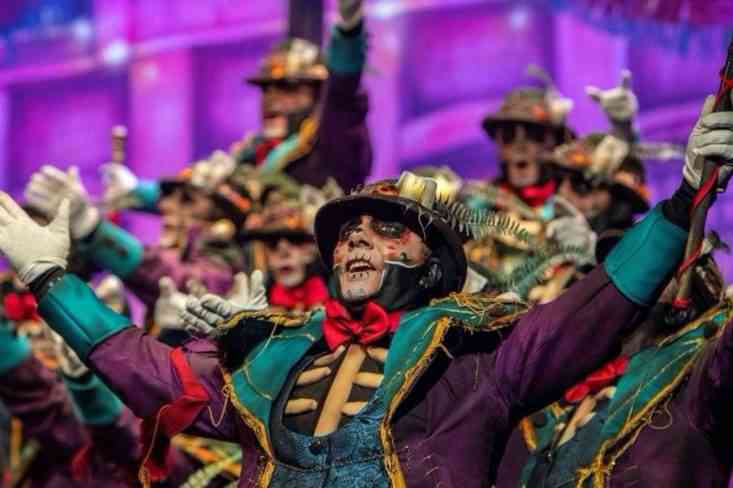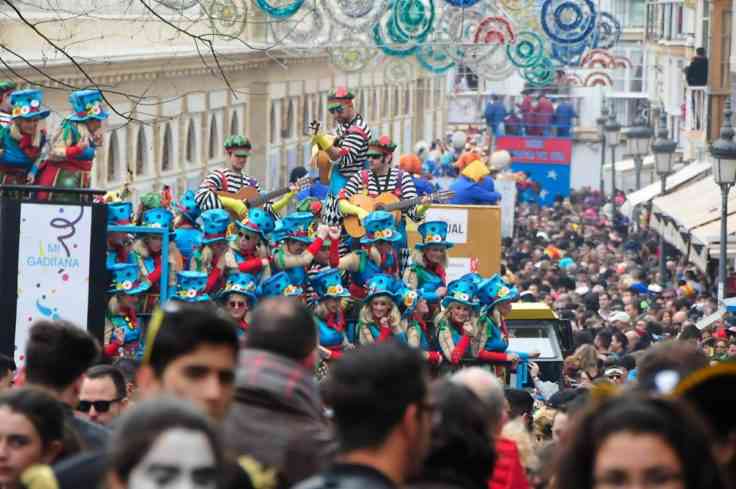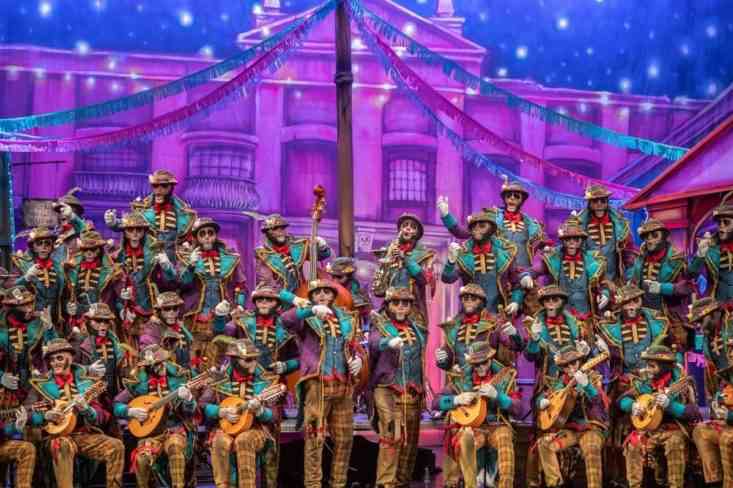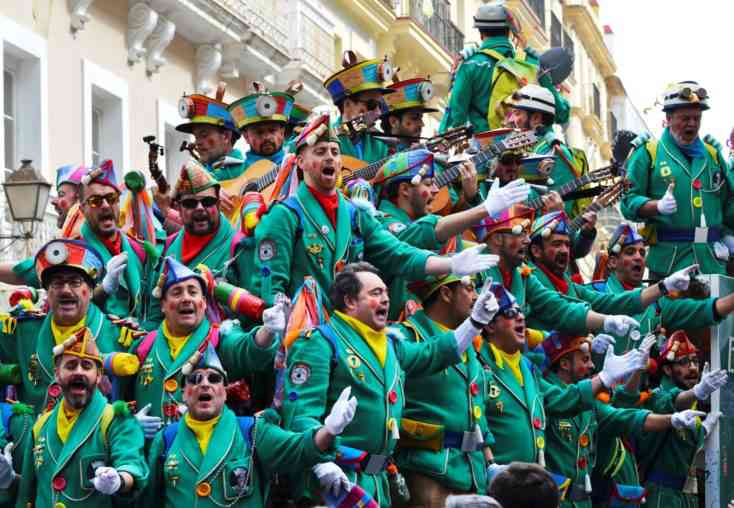Cadiz, a port town in southwest Spain, has a ten-day colorful carnival every year. The carnival is one of the most important in Spain. Cadiz is the oldest known city in the Iberian Peninsula, dating back 3,000 years.
During the 10 days of carnival festivities, it transforms into the largest and most colorful metropolitan hub in Spain. The carnival features street entertainment, dance and singing, a variety of gastronomy activities, parades, comedic singing acts, open-air dance parties, fireworks displays, and more…
The Cadiz Carnival is a fantastic opportunity for tourists and visitors who want to get a true flavor of Spanish culture through merrymaking and celebrations. The festival outstands for its extravagant and amusing costumes. You can expect to see a parade of humorous creative characters from all over the world. All singing and dancing to some of Spain’s best carnival music.

Contents
Cadiz Carnival’s Beginnings
The origins of the Cádiz Carnival can be traced back to Christianity and Lent. Prior to the fasting and repentance time, the Church used to allow individuals to express all of their feelings. Following this celebration, Lent had the goal of purging people of their vices so that they would come on Resurrection Sunday.
Carnival maintains the cycle of melancholy and joy, which Christianity refers to as “the passionate order of time.” The Cádiz Carnival, as it is currently known, incorporates elements of the Italian Carnival, such as masks and confetti. Genoese traders brought them to the Andalusian province in the 15th century
However, The City Council did not recognize the Carnival as its own festival until 1861. The mayor Don Juan Valverde proposed that the city hall be in charge of organizing the Carnival. For which it was requested that the expenses be foreseen in the 1862 budget of this party.

How Cádiz celebrates its Carnival
During the Cadiz Carnival holidays, the streets of Cádiz come alive. On the one hand, with Choir Carrousels-parades of groups competing at the Falla Theater. On the other hand, ‘illegal’ bands, bands formed by groups of friends, clubs, or colleagues who participate in the carnival and perform on the streets.
Every year, the carnival features a diverse array of colorful performances, humor, and music that lasts at least ten days! Processions, concerts, puppet displays, fireworks, and, of course, plenty of singing in the streets are all part of the event. That’s not all; there are also scheduled performances, which usually start in the afternoon with La Tronada (The Thunder). This is an ear-shattering explosion of fireworks that takes place in Plaza San Juan de Dios. Following that, the action continues till morning.

Competition for musical groups
The Official Contest at the Gran Teatro Falla is another unique feature of the Cádiz Carnival. At the competition stage, over 100 groups from four different styles compete. Four groups per style advanced to the semi-finals after several weeks of performances. The final takes place on Saturday, soon before the first Carnival. Thousands of people tune in to the show on radio and television, despite its length.

Carnival Performances in Cádiz
There are four different styles of performances, ranging from musical to comedic, so there is something for everyone.
- Chirigotas are comedic groups who put on sarcastic shows about everything and everything.
- Comparsas are the carnival’s most serious singers, known for their classical music skills and thoughtful song selection.
- Quartets are made up of four or more performers and are frequently accompanied by a variety of noises, such as a kazoo or the thumping of sticks or other similar instruments.
- Choirs of up to 30 individuals can range from amusing to solemn and amuse passers-by with stringed instruments.

By turismo de Cadiz
Schedule for the Cádiz Carnival
This year, Cadiz carnival begins on June 9 and will last for 11 days. Although the costumes are a big part of the carnival every year, this year’s carnival is all about the music ! Locals put in a lot of effort throughout the year to develop their acts and performances for the carnival.
However, in a meeting, the street groups decided to go to the streets throughout the month of February. The days when the Carnival would have been held if there had been no sanitary alert.
What is the best way to get around in Cádiz?
Visitors to Cádiz have a variety of choices for getting around the city. The closest airport is Jerez Airport, which is around 30 minutes away from the city. A variety of bus routes run from most major Spanish cities to Cadiz.
With several modes of transportation accessible, getting around Cádiz is quick and straightforward. The bus or taxi are the most popular modes of transportation. In addition, a railroad line passes through Cádiz, with two stops within the city, linking visitors to nearby towns.
Because of the city’s size, public transportation is frequently available yet not always necessary, as you can get to the majority of places on foot. Rental bikes and electric scooters are also available throughout the city and are a popular mode of transportation.
The best composers of Cadiz Carnival
Not only in Cadiz, but also in the rest of the province and Andalusia, the Gran Teatro Falla competition has a strong following. Over 100 groups fight for a total of 20 days for a chance to advance to the semifinals and finals, when only four groupings per kind are selected. Within those 100 groups some of the most important and well-known ones are for instance:
Antonio Martinez Ares and Juan Carlos Aragón, who this year have picked the songs ‘Los Carnavales’ and ‘La Gaditanissima’ to represent a new work. Los Carapapas, Enrique Garca Rosado, aka ‘Kike Remolino’, Faly Mosquera or Germán Garca. It is also worth mentioning Tino Tovar.
Antonio Martinez Ares
He is a musician and singer-songwriter born in Cádiz, as well as being a recognized author of comparsas in the Cádiz Carnival.
He has left an indelible impression on the history of the Cadiz Carnival, and is regarded as one of the most influential authors since Paco Alba. Seven of the 20 comparsas have won, and another 11 have qualified for the final. Surprising outcomes of music enshrined in a subject dedicated to carnival that has been consistently reinvented throughout the years, with flawless inspiration in Cádiz; fusing nostalgia with the present.
Juan Carlos Aragón
He was a philosopher, teacher, poet and musician from Cádiz, author of more than 40 comparsas and chirigotas of the Cádiz Carnival. Aragón was one of the most popular composers both inside and outside of the competition, capable of stirring emotions like no one other, for or against. Although he began his career with youth groups at the Cadiz Carnival when he was very young, it is his curriculum beginning in 1994 with Un Peasso Coro, a group that finished only nine points short of the final, followed the following year by Los Tintos de Verano, with whom he won the first Cajonazo Prize —the first of those that the contest had reserved for him— that is remembered most. With the chirigota Los Guiris, he made it to the finals for the first time in 1996, winning fourth place in his modality.
For more info and insights, get in touch with us here or write to us at info@alsherry.com and we’d be delighted to arrange / make plans with you or for you!
